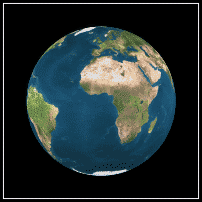 Geophysical
Fluid Dynamics Research Group
Geophysical
Fluid Dynamics Research Group
University
of Alberta
|
|
Research Program
The ocean is the regulator of Earth's
climate. The world's oceans store an enormous quantity of heat that is
redistributed throughout the world via the currents. Because the density of
water is about a thousand times larger than the density of air, the ocean has a
substantial inertia associated with it compared to the atmosphere. This implies
that it takes an enormous quantity of energy to change an existing ocean
circulatory pattern as compared to the atmospheric winds. For this reason, one
can think of the ocean as the "memory" and "integrator" of
past and evolving climate states. Because of the dominant role played by the
ocean in climate change, it is vital to understand the long time temporal
variability that can occur in ocean dynamics on a planetary scale.
Ocean currents can be characterized into
two broad groups. The first are the currents that are wind driven. These
currents are most intense near the surface of the ocean. Their principal role
is to transport warm equatorial waters toward the
My research group has worked toward
understanding the dynamics of these abyssal currents. In particular, we have
focused on developing mathematical and computational models to describe the
evolution, including the transition to instability and interaction with the
surrounding ocean, of these flows. The goal of this research is to better
understand the temporal variability of the planetary scale dynamics of the
ocean climate system. Our work can be seen as "theoretical" in the
sense that we attempt to develop new models to elucidate the most important
dynamical balances at play and "process-oriented" in the sense that
we attempt to use these models to make concrete predictions about the evolution
of these flows. As such, our work is an interdisciplinary blend of physical
oceanography, classical applied mathematics and high-performance computational
science.
My Erdös number is 3 (Paul Erdös to George Szekeres to Lawrence Mysak to me).
My Einstein number is 4 (Albert Einstein to Ernst Straus to George Szekeres to Lawrence Mysak to me).
Here is my Academic Lineage.
